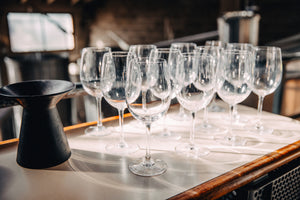In recent years, wine drinkers have been bombarded with marketing claims about calories and wine, promising "low-sugar" or "low-calorie" variations, often paired with images of guilt-free indulgence. As winemakers in Ontario, we believe it’s time to shed light on these claims and offer a transparent perspective on the sugar and calorie content in wine.
Dry vs. Sweet: What’s in Your Glass?
It all starts in the vineyard. In cooler climates like ours, grapes ripen at lower sugar levels compared to warmer regions. This means our wines naturally have less sugar and often result in lower alcohol levels too. When making dry wines—like our Pinot Noir and Chardonnay—we ferment the grape sugars almost completely, leaving little to no residual sugar. Sweet wines, on the other hand, stop fermentation earlier or use naturally sweeter grape varieties, leading to higher sugar content.
For context, a typical dry wine has less than 4 grams of sugar per liter (roughly 0.5 grams per 5 oz. glass). That’s significantly lower than many commercial beverages marketed as "healthy." Sweet wines, such as dessert wines, can range from 50–200 grams of sugar per liter—but they’re meant for smaller portions and occasional enjoyment.
The Myth of 'Low-Sugar' Wines
Here’s the truth: all dry wines are inherently low in sugar. When you see 'low-sugar' labels on wines, it’s often a clever marketing spin rather than a unique feature. What matters more is the winemaker’s approach. Are they adding sugar or other additives to manipulate the wine? Is the wine fermented naturally to highlight the best expression of the fruit?
We can proudly say we don’t add sugar at any point in our winemaking process. Our wines reflect the natural balance of our grapes and the care we take in the vineyard.
Calories and Wine: A Question of Alcohol
If you’re counting calories, it’s alcohol—not sugar—that plays the bigger role. Every gram of alcohol contributes about 7 calories (compared to 4 calories per gram of sugar). A glass of wine with 12% alcohol typically contains 120–130 calories, while higher-alcohol wines can reach 150 calories or more.
In our cool climate, the lower natural sugar levels in our grapes mean we’re crafting wines with moderate alcohol levels. This not only aligns with our taste preferences but also means our wines are lighter on calories compared to those from hotter regions.
Quality Over Quantity
The healthiest choice isn’t about sugar grams or calorie counts—it’s about choosing wine made with care, intention, and integrity. A single glass of thoughtfully crafted wine, enjoyed with a meal and good company, is worth far more than two glasses of something mass-produced.
So the next time you’re browsing wine labels or scrolling through ads promising health-conscious options, remember: a trustworthy winemaker doesn’t need to rely on gimmicks. Look for transparency, ask questions, and choose wines that resonate with your values.
Here’s to raising a glass—responsibly and joyfully!
Share Your Westcott Experience!
We love seeing your wine tasting memories! Share your photos and experiences with us on Instagram by tagging @WestcottVineyards and using the hashtag #WestcottWines.
If you enjoyed your visit, we’d greatly appreciate your Google review—it helps others discover the magic of Westcott! Leave a Review Here.


